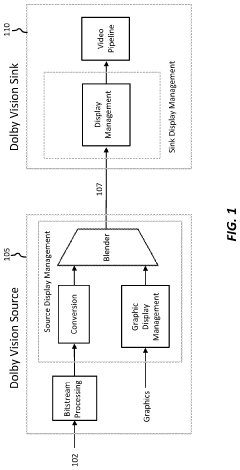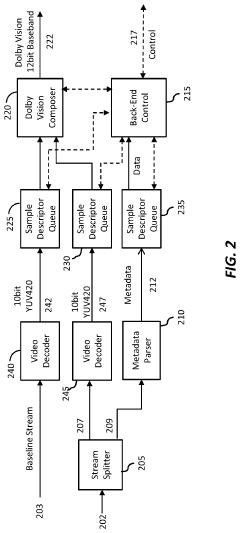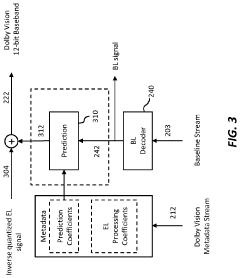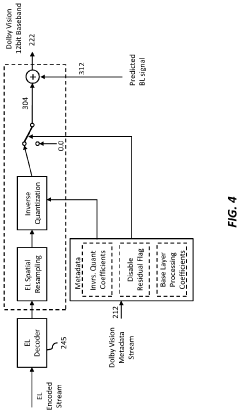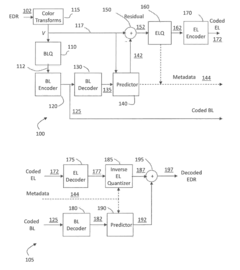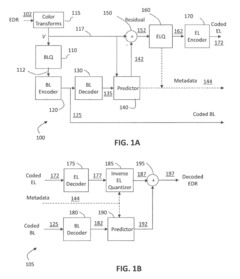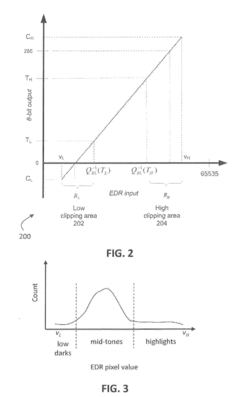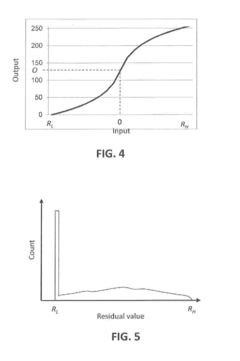Exploring Dolby Vision in Interactive Storytelling Applications
JUL 30, 20259 MIN READ
Generate Your Research Report Instantly with AI Agent
Patsnap Eureka helps you evaluate technical feasibility & market potential.
Dolby Vision Evolution and Objectives
Dolby Vision, a cutting-edge High Dynamic Range (HDR) technology, has undergone significant evolution since its inception in 2014. Initially developed for cinema and high-end televisions, Dolby Vision has expanded its reach to encompass a broader range of devices and applications. The technology's primary objective has been to deliver a more immersive and lifelike visual experience by enhancing contrast, brightness, and color accuracy.
The evolution of Dolby Vision has been marked by several key milestones. In its early stages, the focus was on optimizing content for theatrical releases and premium television sets. As the technology matured, Dolby Vision expanded to mobile devices, gaming consoles, and streaming platforms, adapting to the diverse ecosystem of modern media consumption.
One of the most significant developments in Dolby Vision's evolution has been its integration with content creation tools. This has enabled filmmakers, game developers, and other content creators to leverage the technology's capabilities from the outset of the production process, ensuring a more consistent and high-quality visual experience across different platforms and devices.
In recent years, Dolby Vision has set its sights on interactive storytelling applications, recognizing the growing convergence of traditional media and interactive experiences. This new frontier presents both exciting opportunities and unique challenges for the technology. The primary objective in this domain is to maintain the visual fidelity and immersive qualities of Dolby Vision while adapting to the dynamic nature of interactive narratives.
To achieve this, Dolby Vision is evolving to support real-time rendering and dynamic adjustments based on user interactions. This requires the development of more sophisticated algorithms and processing techniques that can adapt to changing scenes and lighting conditions on the fly, without compromising the overall visual quality or introducing latency.
Another key objective for Dolby Vision in interactive storytelling is to enhance the emotional impact of narratives through superior visual presentation. By leveraging its advanced color grading and dynamic range capabilities, Dolby Vision aims to create more engaging and immersive interactive experiences that can evoke stronger emotional responses from users.
As Dolby Vision continues to evolve, its objectives extend beyond mere technical improvements. The technology seeks to establish itself as an essential component of next-generation storytelling platforms, bridging the gap between traditional cinematic experiences and interactive digital narratives. This ambitious goal requires ongoing collaboration with content creators, game developers, and hardware manufacturers to ensure seamless integration and optimal performance across a wide range of interactive storytelling applications.
The evolution of Dolby Vision has been marked by several key milestones. In its early stages, the focus was on optimizing content for theatrical releases and premium television sets. As the technology matured, Dolby Vision expanded to mobile devices, gaming consoles, and streaming platforms, adapting to the diverse ecosystem of modern media consumption.
One of the most significant developments in Dolby Vision's evolution has been its integration with content creation tools. This has enabled filmmakers, game developers, and other content creators to leverage the technology's capabilities from the outset of the production process, ensuring a more consistent and high-quality visual experience across different platforms and devices.
In recent years, Dolby Vision has set its sights on interactive storytelling applications, recognizing the growing convergence of traditional media and interactive experiences. This new frontier presents both exciting opportunities and unique challenges for the technology. The primary objective in this domain is to maintain the visual fidelity and immersive qualities of Dolby Vision while adapting to the dynamic nature of interactive narratives.
To achieve this, Dolby Vision is evolving to support real-time rendering and dynamic adjustments based on user interactions. This requires the development of more sophisticated algorithms and processing techniques that can adapt to changing scenes and lighting conditions on the fly, without compromising the overall visual quality or introducing latency.
Another key objective for Dolby Vision in interactive storytelling is to enhance the emotional impact of narratives through superior visual presentation. By leveraging its advanced color grading and dynamic range capabilities, Dolby Vision aims to create more engaging and immersive interactive experiences that can evoke stronger emotional responses from users.
As Dolby Vision continues to evolve, its objectives extend beyond mere technical improvements. The technology seeks to establish itself as an essential component of next-generation storytelling platforms, bridging the gap between traditional cinematic experiences and interactive digital narratives. This ambitious goal requires ongoing collaboration with content creators, game developers, and hardware manufacturers to ensure seamless integration and optimal performance across a wide range of interactive storytelling applications.
Interactive Storytelling Market Analysis
The interactive storytelling market has experienced significant growth in recent years, driven by advancements in technology and changing consumer preferences. This market segment encompasses a wide range of applications, including video games, educational content, virtual reality experiences, and interactive films. The integration of Dolby Vision technology into this space presents exciting opportunities for enhancing visual quality and immersion in interactive narratives.
Market demand for interactive storytelling applications has been steadily increasing, with the global market size estimated to reach several billion dollars by 2025. This growth is fueled by the rising popularity of immersive entertainment experiences and the increasing adoption of virtual and augmented reality technologies. The gaming industry, in particular, has been a major driver of this market, with interactive storytelling elements becoming increasingly prevalent in both mainstream and indie titles.
The potential market capacity for Dolby Vision-enhanced interactive storytelling applications is substantial. As consumers become more accustomed to high-quality visual experiences in their entertainment content, there is a growing expectation for similar standards in interactive media. Dolby Vision's ability to deliver enhanced contrast, brightness, and color depth aligns well with these expectations, potentially creating a new premium segment within the interactive storytelling market.
Industry trends indicate a shift towards more sophisticated and visually compelling interactive narratives. This trend is particularly evident in the convergence of traditional storytelling mediums, such as film and television, with interactive elements. Streaming platforms are experimenting with interactive content, while game developers are pushing the boundaries of visual fidelity and narrative complexity. The integration of Dolby Vision technology into these applications could serve as a differentiator in a competitive market.
The adoption of Dolby Vision in interactive storytelling also aligns with the broader trend of technological convergence in the entertainment industry. As the lines between different forms of media continue to blur, technologies that can enhance the visual experience across multiple platforms are likely to see increased demand. This convergence presents opportunities for cross-platform storytelling experiences that leverage Dolby Vision's capabilities to create visually consistent and immersive narratives across different devices and mediums.
However, challenges exist in terms of content creation and distribution for Dolby Vision-enhanced interactive storytelling. The technology requires specialized hardware and software support, which may limit its initial adoption to high-end devices and premium content. Additionally, the development of interactive content that fully utilizes Dolby Vision's capabilities may require new tools and workflows, potentially increasing production costs and complexity.
Market demand for interactive storytelling applications has been steadily increasing, with the global market size estimated to reach several billion dollars by 2025. This growth is fueled by the rising popularity of immersive entertainment experiences and the increasing adoption of virtual and augmented reality technologies. The gaming industry, in particular, has been a major driver of this market, with interactive storytelling elements becoming increasingly prevalent in both mainstream and indie titles.
The potential market capacity for Dolby Vision-enhanced interactive storytelling applications is substantial. As consumers become more accustomed to high-quality visual experiences in their entertainment content, there is a growing expectation for similar standards in interactive media. Dolby Vision's ability to deliver enhanced contrast, brightness, and color depth aligns well with these expectations, potentially creating a new premium segment within the interactive storytelling market.
Industry trends indicate a shift towards more sophisticated and visually compelling interactive narratives. This trend is particularly evident in the convergence of traditional storytelling mediums, such as film and television, with interactive elements. Streaming platforms are experimenting with interactive content, while game developers are pushing the boundaries of visual fidelity and narrative complexity. The integration of Dolby Vision technology into these applications could serve as a differentiator in a competitive market.
The adoption of Dolby Vision in interactive storytelling also aligns with the broader trend of technological convergence in the entertainment industry. As the lines between different forms of media continue to blur, technologies that can enhance the visual experience across multiple platforms are likely to see increased demand. This convergence presents opportunities for cross-platform storytelling experiences that leverage Dolby Vision's capabilities to create visually consistent and immersive narratives across different devices and mediums.
However, challenges exist in terms of content creation and distribution for Dolby Vision-enhanced interactive storytelling. The technology requires specialized hardware and software support, which may limit its initial adoption to high-end devices and premium content. Additionally, the development of interactive content that fully utilizes Dolby Vision's capabilities may require new tools and workflows, potentially increasing production costs and complexity.
Dolby Vision Technical Challenges
Dolby Vision implementation in interactive storytelling applications faces several technical challenges that need to be addressed for seamless integration and optimal user experience. One of the primary hurdles is the real-time rendering of high dynamic range (HDR) content within interactive environments. Unlike traditional linear media, interactive storytelling requires on-the-fly content generation and adaptation, which can strain computational resources when combined with Dolby Vision's demanding HDR processing.
Another significant challenge lies in maintaining consistent color grading and tone mapping across various devices and display technologies. Interactive storytelling often involves multiple viewing platforms, from high-end HDR televisions to mobile devices with limited color gamuts. Ensuring that the creator's artistic intent is preserved across this diverse ecosystem while leveraging Dolby Vision's capabilities presents a complex technical problem.
The dynamic nature of interactive narratives also poses challenges for metadata management in Dolby Vision workflows. Traditional Dolby Vision content relies on static metadata for optimal HDR presentation. However, interactive storytelling may require real-time metadata adjustments to account for user choices and dynamic scene changes, necessitating the development of more flexible and responsive metadata systems.
Furthermore, the integration of Dolby Vision with existing game engines and interactive content creation tools presents compatibility issues. Many current development platforms are not natively equipped to handle Dolby Vision's specific color science and HDR requirements, requiring extensive modifications or the creation of new plugins and middleware solutions.
Bandwidth and storage constraints also come into play when implementing Dolby Vision in interactive applications, especially for streaming or cloud-based services. The increased data requirements for HDR content can lead to longer load times and higher bandwidth usage, potentially impacting the responsiveness and accessibility of interactive experiences.
Lastly, the challenge of maintaining consistent frame rates while processing Dolby Vision content in real-time is significant. The additional computational overhead required for HDR rendering and dynamic metadata processing can lead to performance bottlenecks, particularly on less powerful devices or in complex interactive scenes. Balancing visual fidelity with smooth interactivity remains a key technical hurdle in the implementation of Dolby Vision for interactive storytelling applications.
Another significant challenge lies in maintaining consistent color grading and tone mapping across various devices and display technologies. Interactive storytelling often involves multiple viewing platforms, from high-end HDR televisions to mobile devices with limited color gamuts. Ensuring that the creator's artistic intent is preserved across this diverse ecosystem while leveraging Dolby Vision's capabilities presents a complex technical problem.
The dynamic nature of interactive narratives also poses challenges for metadata management in Dolby Vision workflows. Traditional Dolby Vision content relies on static metadata for optimal HDR presentation. However, interactive storytelling may require real-time metadata adjustments to account for user choices and dynamic scene changes, necessitating the development of more flexible and responsive metadata systems.
Furthermore, the integration of Dolby Vision with existing game engines and interactive content creation tools presents compatibility issues. Many current development platforms are not natively equipped to handle Dolby Vision's specific color science and HDR requirements, requiring extensive modifications or the creation of new plugins and middleware solutions.
Bandwidth and storage constraints also come into play when implementing Dolby Vision in interactive applications, especially for streaming or cloud-based services. The increased data requirements for HDR content can lead to longer load times and higher bandwidth usage, potentially impacting the responsiveness and accessibility of interactive experiences.
Lastly, the challenge of maintaining consistent frame rates while processing Dolby Vision content in real-time is significant. The additional computational overhead required for HDR rendering and dynamic metadata processing can lead to performance bottlenecks, particularly on less powerful devices or in complex interactive scenes. Balancing visual fidelity with smooth interactivity remains a key technical hurdle in the implementation of Dolby Vision for interactive storytelling applications.
Current Dolby Vision Implementation
01 Display technology for enhanced image quality
Dolby Vision is an advanced display technology that enhances image quality by improving color depth, brightness, and contrast. It utilizes high dynamic range (HDR) techniques to provide a more immersive viewing experience with greater detail in both bright and dark areas of the image.- Display technology for enhanced image quality: Dolby Vision is an advanced display technology that enhances image quality by improving contrast, brightness, and color accuracy. It utilizes high dynamic range (HDR) and wide color gamut techniques to deliver more vibrant and lifelike visuals on compatible displays.
- Audio-visual synchronization and processing: The technology incorporates sophisticated audio-visual synchronization and processing methods to ensure a seamless integration of high-quality video and audio. This includes techniques for maintaining lip-sync and optimizing sound quality to complement the enhanced visual experience.
- Content creation and mastering tools: Dolby Vision provides content creators with advanced tools and workflows for mastering and optimizing content. These tools enable precise control over color grading, brightness levels, and other visual parameters to ensure the best possible representation of the content across different display devices.
- Adaptive optimization for various display devices: The technology incorporates adaptive optimization algorithms that adjust content dynamically based on the capabilities of the display device. This ensures that viewers experience the best possible image quality regardless of the specific hardware they are using, from high-end TVs to mobile devices.
- Integration with other multimedia technologies: Dolby Vision is designed to integrate seamlessly with other multimedia technologies and standards. This includes compatibility with various video codecs, streaming protocols, and content delivery systems, allowing for widespread adoption across different platforms and devices.
02 Audio-visual synchronization and processing
The technology incorporates sophisticated audio-visual synchronization and processing techniques to ensure seamless integration of high-quality video and audio. This includes methods for aligning audio and video streams, as well as optimizing sound quality to complement the enhanced visual experience.Expand Specific Solutions03 Content creation and mastering tools
Dolby Vision includes a suite of content creation and mastering tools that enable filmmakers and content producers to optimize their material for the technology. These tools allow for precise control over color grading, brightness levels, and other visual parameters to ensure the best possible presentation across different display devices.Expand Specific Solutions04 Adaptive optimization for various displays
The technology incorporates adaptive optimization algorithms that adjust content dynamically based on the capabilities of the display device. This ensures that viewers experience the best possible image quality regardless of whether they are using a high-end television or a mobile device with more limited display capabilities.Expand Specific Solutions05 Integration with existing video standards and formats
Dolby Vision is designed to be compatible with existing video standards and formats, allowing for seamless integration into current content delivery systems. This includes support for various resolutions, frame rates, and color spaces, as well as backward compatibility with non-Dolby Vision enabled devices.Expand Specific Solutions
Key Dolby Vision Stakeholders
The competitive landscape for Dolby Vision in interactive storytelling applications is evolving rapidly, with the market still in its early growth stage. As the technology matures, it's attracting interest from major players across the entertainment and technology sectors. Companies like Apple, Microsoft, Google, and Sony are investing in this space, leveraging their expertise in content creation and display technologies. The market size is expanding as consumers demand more immersive and high-quality visual experiences. While Dolby Laboratories remains a key innovator, other tech giants are developing their own solutions, potentially leading to a more diverse and competitive ecosystem in the near future.
Apple, Inc.
Technical Solution: Apple has integrated Dolby Vision support into its ecosystem, including devices and content creation tools. For interactive storytelling, Apple's approach focuses on seamless integration with their ARKit and Metal graphics API. They have developed a pipeline that allows real-time rendering of Dolby Vision content in augmented reality applications, enhancing the visual fidelity of interactive narratives[4]. Apple's implementation includes on-device tone mapping and color grading, which enables dynamic adjustments based on ambient lighting conditions, crucial for mobile AR storytelling experiences[5]. Additionally, Apple has introduced tools for content creators to easily author and preview Dolby Vision content within their development environments, streamlining the production process for interactive narratives[6].
Strengths: Tight integration with iOS ecosystem, powerful on-device processing, strong developer support. Weaknesses: Limited to Apple devices, potential performance constraints on older hardware.
Google LLC
Technical Solution: Google has been exploring Dolby Vision in interactive storytelling through its Android platform and cloud gaming service, Stadia. Their approach involves implementing Dolby Vision support at the system level in Android, allowing game developers to leverage HDR capabilities across a wide range of devices[7]. For cloud gaming, Google has developed a unique streaming technology that can deliver Dolby Vision content with minimal latency, crucial for interactive storytelling applications[8]. They have also created tools for developers to easily integrate Dolby Vision into their games and interactive experiences, including automatic HDR tonemapping and color space conversion[9]. Google's implementation focuses on scalability, ensuring that Dolby Vision content can be adapted to various display capabilities while maintaining visual quality.
Strengths: Wide reach through Android platform, cloud gaming expertise, scalable implementation. Weaknesses: Fragmentation in Android ecosystem may lead to inconsistent experiences, reliance on internet connectivity for cloud-based solutions.
Dolby Vision Patents and Literature
Layered representation and delivery of high dynamic range video
PatentActiveUS20190373290A1
Innovation
- The implementation of a layered representation and delivery system for HDR video, utilizing Dolby Vision technology, which includes a base layer and enhancement layer, along with metadata processing to reconstruct HDR signals, ensuring seamless playback on compatible displays.
Layered Decomposition of Chroma Components in EDR Video Coding
PatentActiveUS20160065975A1
Innovation
- A dual-layer EDR video encoder employs joint adaptation of base layer and enhancement layer quantizers, optimizing parameter selection to minimize distortion and bit requirements, allowing for efficient coding and decoding of EDR video streams that can be rendered on both legacy and HDR displays.
Content Creation Workflow
The content creation workflow for Dolby Vision in interactive storytelling applications involves a series of steps designed to leverage the technology's enhanced dynamic range and color capabilities. This process begins with the capture of high-quality HDR footage using cameras capable of recording in wide color gamut and high dynamic range formats.
Once the raw footage is obtained, it undergoes a meticulous color grading process. This step is crucial in Dolby Vision workflows, as it allows content creators to take full advantage of the expanded color and brightness range. Specialized color grading tools and monitors that support Dolby Vision are used to ensure accurate representation of the intended visual experience.
The next phase involves the integration of interactive elements into the Dolby Vision-enhanced content. This requires careful consideration of how user interactions might affect the visual presentation. Developers must create adaptive algorithms that can adjust the HDR metadata in real-time based on user inputs or story progression.
Asset management becomes more complex in Dolby Vision interactive storytelling. Multiple versions of assets may need to be created to accommodate different display capabilities while maintaining the creator's artistic intent. This includes generating both HDR and SDR versions of content, as well as intermediate versions for various device specifications.
The rendering pipeline for interactive Dolby Vision content must be optimized to handle the increased data load associated with HDR content. This often involves implementing efficient compression techniques and leveraging hardware acceleration to maintain smooth performance across various devices.
Testing and quality assurance play a critical role in the workflow. Content must be verified on a range of Dolby Vision-capable displays to ensure consistency and proper implementation of the technology. This includes checking for color accuracy, brightness levels, and the effectiveness of the interactive HDR elements across different viewing conditions.
Finally, the delivery process for Dolby Vision interactive content requires careful packaging and metadata management. The content must be encoded with the appropriate Dolby Vision profile and include the necessary metadata to guide playback devices in rendering the content correctly. This ensures that the enhanced visual experience is preserved across the distribution chain and delivered as intended to the end-user.
Once the raw footage is obtained, it undergoes a meticulous color grading process. This step is crucial in Dolby Vision workflows, as it allows content creators to take full advantage of the expanded color and brightness range. Specialized color grading tools and monitors that support Dolby Vision are used to ensure accurate representation of the intended visual experience.
The next phase involves the integration of interactive elements into the Dolby Vision-enhanced content. This requires careful consideration of how user interactions might affect the visual presentation. Developers must create adaptive algorithms that can adjust the HDR metadata in real-time based on user inputs or story progression.
Asset management becomes more complex in Dolby Vision interactive storytelling. Multiple versions of assets may need to be created to accommodate different display capabilities while maintaining the creator's artistic intent. This includes generating both HDR and SDR versions of content, as well as intermediate versions for various device specifications.
The rendering pipeline for interactive Dolby Vision content must be optimized to handle the increased data load associated with HDR content. This often involves implementing efficient compression techniques and leveraging hardware acceleration to maintain smooth performance across various devices.
Testing and quality assurance play a critical role in the workflow. Content must be verified on a range of Dolby Vision-capable displays to ensure consistency and proper implementation of the technology. This includes checking for color accuracy, brightness levels, and the effectiveness of the interactive HDR elements across different viewing conditions.
Finally, the delivery process for Dolby Vision interactive content requires careful packaging and metadata management. The content must be encoded with the appropriate Dolby Vision profile and include the necessary metadata to guide playback devices in rendering the content correctly. This ensures that the enhanced visual experience is preserved across the distribution chain and delivered as intended to the end-user.
User Experience Considerations
When exploring Dolby Vision in interactive storytelling applications, user experience considerations play a crucial role in ensuring the technology's successful implementation and adoption. The enhanced visual quality offered by Dolby Vision must be seamlessly integrated into the interactive narrative to create a compelling and immersive experience for users.
One of the primary considerations is the adaptation of Dolby Vision's high dynamic range (HDR) capabilities to various devices and viewing environments. Interactive storytelling applications may be accessed on a wide range of devices, from high-end televisions to mobile phones. Ensuring consistent visual quality across these diverse platforms is essential for maintaining user engagement and satisfaction.
Content creators must also consider how Dolby Vision's expanded color gamut and contrast can be leveraged to enhance storytelling elements. The technology's ability to display a wider range of colors and deeper blacks can be used to create more visually striking scenes, emphasizing mood and atmosphere in ways that were previously impossible. However, care must be taken to ensure that these visual enhancements do not overshadow or distract from the interactive narrative itself.
The integration of Dolby Vision into user interfaces and interactive elements presents both opportunities and challenges. While the technology can be used to create more visually appealing and intuitive interfaces, designers must be mindful of potential issues such as eye strain or visual fatigue during extended viewing sessions. Balancing visual impact with user comfort is crucial for maintaining a positive user experience.
Another important consideration is the potential impact of Dolby Vision on load times and performance, particularly in streaming or real-time rendering scenarios. The increased data requirements of HDR content may necessitate optimizations to ensure smooth playback and interactivity, especially on lower-end devices or in areas with limited bandwidth.
User customization options should also be considered, allowing viewers to adjust HDR settings to their preferences or viewing conditions. This may include options to toggle Dolby Vision on or off, or to fine-tune brightness and contrast levels for optimal viewing comfort.
Lastly, accessibility considerations must not be overlooked. While Dolby Vision can enhance the visual experience for many users, it's important to ensure that the interactive storytelling application remains accessible to those with visual impairments or color vision deficiencies. This may involve providing alternative display modes or ensuring that critical information is not conveyed solely through color or contrast differences.
One of the primary considerations is the adaptation of Dolby Vision's high dynamic range (HDR) capabilities to various devices and viewing environments. Interactive storytelling applications may be accessed on a wide range of devices, from high-end televisions to mobile phones. Ensuring consistent visual quality across these diverse platforms is essential for maintaining user engagement and satisfaction.
Content creators must also consider how Dolby Vision's expanded color gamut and contrast can be leveraged to enhance storytelling elements. The technology's ability to display a wider range of colors and deeper blacks can be used to create more visually striking scenes, emphasizing mood and atmosphere in ways that were previously impossible. However, care must be taken to ensure that these visual enhancements do not overshadow or distract from the interactive narrative itself.
The integration of Dolby Vision into user interfaces and interactive elements presents both opportunities and challenges. While the technology can be used to create more visually appealing and intuitive interfaces, designers must be mindful of potential issues such as eye strain or visual fatigue during extended viewing sessions. Balancing visual impact with user comfort is crucial for maintaining a positive user experience.
Another important consideration is the potential impact of Dolby Vision on load times and performance, particularly in streaming or real-time rendering scenarios. The increased data requirements of HDR content may necessitate optimizations to ensure smooth playback and interactivity, especially on lower-end devices or in areas with limited bandwidth.
User customization options should also be considered, allowing viewers to adjust HDR settings to their preferences or viewing conditions. This may include options to toggle Dolby Vision on or off, or to fine-tune brightness and contrast levels for optimal viewing comfort.
Lastly, accessibility considerations must not be overlooked. While Dolby Vision can enhance the visual experience for many users, it's important to ensure that the interactive storytelling application remains accessible to those with visual impairments or color vision deficiencies. This may involve providing alternative display modes or ensuring that critical information is not conveyed solely through color or contrast differences.
Unlock deeper insights with Patsnap Eureka Quick Research — get a full tech report to explore trends and direct your research. Try now!
Generate Your Research Report Instantly with AI Agent
Supercharge your innovation with Patsnap Eureka AI Agent Platform!
